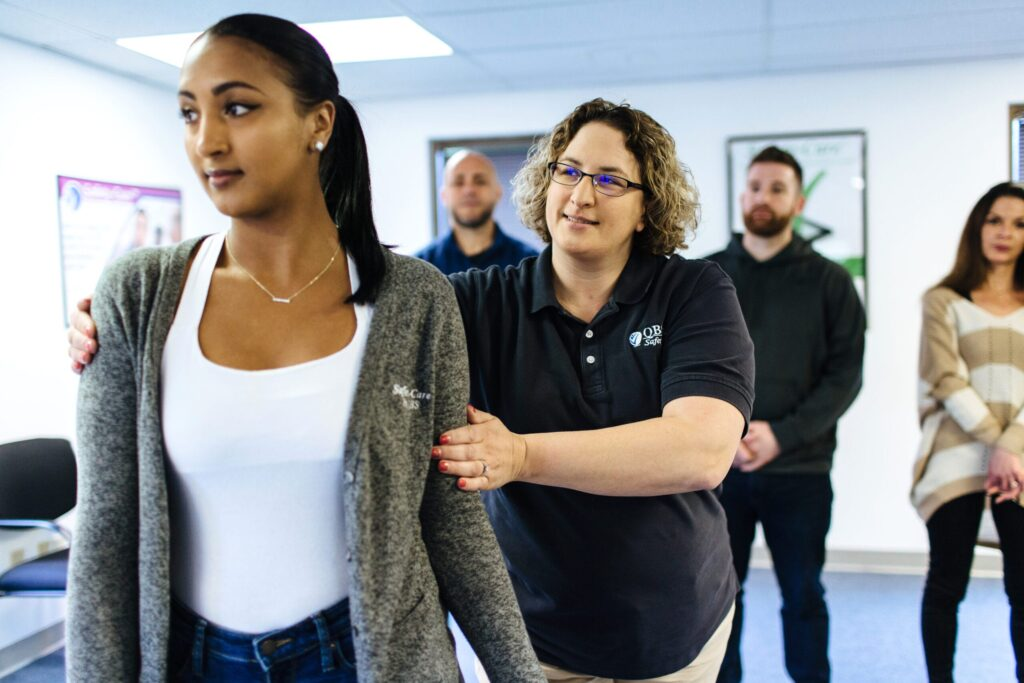Kansas Department of Education – Safety Interventions
Upon the adoption of K.A.R. 91-42-2, Kansas schools were provided a new set of regulations to implement regarding school safety. Safety-Care can be used as a vital training tool to help meet the needs of staff and students in providing a safer learning environment. Below is a summary of the regulations.

.png?width=88&height=95&name=Group%20137%20(5).png)


How to Implement Safety-Care?
2. Complete your class to become a certified Safety-Care Trainer for your organization. We bring you to fluency using an errorless teaching methodology.
3. You train and certify your staff in Safety-Care’s effective techniques.
4. Our Master Trainers are available by phone, email, or video to help your organization with any questions or concerns while using or implementing Safety-Care.

Legal Requirements
|
Summary: Last Updated: December, 2024 Upon the adoption of K.A.R. 91-42-2, Kansas schools were provided a new set of regulations to implement regarding school safety. Safety-Care can be used as a vital training tool to help meet the needs of staff and students in providing a safer learning environment. Below is a summary of the regulations. How Safety-Care aligns: Numerous education organizations throughout the United States and Canada rely upon QBS and our Safety-Care training to provide their staff members with the training they need to help maintain a safe and healthy environment. Safety-Care provides a comprehensive, supportive approach to incident prevention, de-escalation, and management. Your Staff will learn practical strategies for helping students that use evidence-based practices consistent with PBIS (Positive Behavior Interventions and Supports) and ABA (Applied Behavior Analysis). |
|
Standards for the use of emergency safety interventions (K.A.R. 91-42-2) (a) An emergency safety intervention shall be used only when a student presents a reasonable and immediate danger of physical harm to the student or others with the present ability to effect such physical harm. Less restrictive alternatives to emergency safety interventions, including positive behavior interventions support, shall be deemed inappropriate or ineffective under the circumstances by the school employee witnessing the student’s behavior before the use of any emergency safety interventions. The use of an emergency safety intervention shall cease as soon as the immediate danger of physical harm ceases to exist. Violent action that is destructive of property may necessitate the use of an emergency safety intervention. (b) Use of an emergency safety intervention for purposes of discipline or punishment or for the convenience of a school employee shall not meet the standard of immediate danger of physical harm. (c)(1) A student shall not be subjected to an emergency safety intervention if the student is known to have a medical condition that could put the student in mental or physical danger as a result of the emergency safety intervention. (d) When a student is placed in seclusion, a school employee shall be able to see and hear the student at all times. (g) The following types of restraint shall be prohibited: (1) Prone, or face-down, physical restraint; (h) The following shall not be deemed an emergency safety intervention, if its use does not otherwise meet the definition of an emergency safety intervention: (1) Physical escort; and How Safety-Care aligns: Safety-Care promotes the use of de-escalation prior to the use of any physical management. Physical management techniques are designed to ensure the safety of all participants and are only to be used until the situation has de-escalated. Safety-Care can be designed and taught to match local requirements regarding restraint but always focuses on the least restrictive and safest methods. All physical management techniques are role-played by trainees to ensure that they fully grasp the need for minimum restriction and full safety of all participants. Our Master Trainers verify each trainees use of these techniques in role-play, further ensuring their safe use. Each trainee must prove mastery of proper technique use before they can be certified in Safety-Care. Safety-Care trainings can be tailored to include or omitted holds and restraints that are prohibited by state and local statutes. |
|
a) Each district shall develop and implement written policies to govern the use of emergency safety interventions over all schools. At a minimum, written district policies shall conform to the standards, definitions, and requirements of this article. The written policies shall also include the following: (1)(A) School personnel training shall be designed to meet the needs of personnel as appropriate to their duties and potential need for the use of emergency safety interventions; (3) a system for the collection and maintenance of documentation for each use of an emergency safety intervention, which shall include the following: (A) The date and time of the emergency safety intervention; (4) procedures for the periodic review of the use of emergency safety intervention at each school, which shall be compiled and submitted at least biannually to the district superintendent or district designee. How Safety-Care aligns: Safety-Care requires that all trainees comply with local laws and regulations regarding reporting and debriefing. Additionally, Safety-Care’s Trainer Connect program can be used to assist in documenting interactions where Safety-Care has been utilized. |
Why Safety-Care?
Benefits & Differentiators
In addition to Safety-Care being highly cost-effective, you get:

Skills to effectively prevent, minimize, & manage behavioral challenges with dignity, safety, & the possibility of change

Decreases in staff and patient injuries and reduction in restraint & seclusion time

Instructional procedures based on decades of evidence-based research & compatible with ABA, PBIS & reinforcement-based environments

Customizable program for your setting, staff & clientele, with a strong focus on preventative via non-intrusive, replacement behaviors

Extremely rigorous standards grounded in errorless teaching methodology

Small, intimate class sizes backed by unlimited support & resources
How Is Safety-Care So Effective?
A Genuine Focus on Implementing & Managing Positive Behavioral Skills
Proactive, environmental management recommendations
Understanding of evocative effects of staff behavior
In-depth analysis of antecedents and proactive antecedent interventions
Evidence-based reinforcement procedures
Required competency in de-escalation skills
Humane, non-invasive touch and QBS Check™ strategies
Evidence-based teaching procedures
Applicable to a wide array of settings, conditions & challenging behavior





